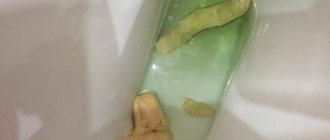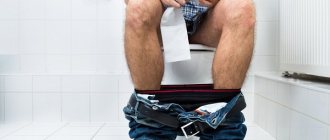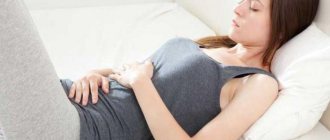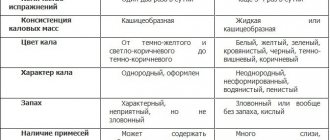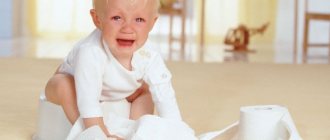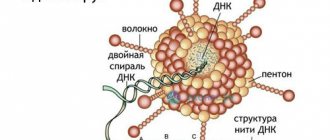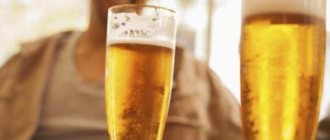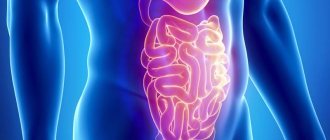Development mechanism
Hologenic diarrhea develops after excessive intake of bile acids (BAs) into the large intestine. It is here that more water and electrolytes are absorbed from the food mass - feces are formed.
The effect of FA on the intestinal walls leads to the production of the enzyme adenylate cyclase, which activates the hormonal messenger cAMP. It interferes with the absorption of water and sodium, which enter the lumen of the colon. After this, secretory diarrhea develops.
FA is formed in liver cells - hepatocytes. Normally, they are deposited in the gallbladder and flow into the duodenum only during meals.
After several transformations, the acids enter the ileum, are broken down by enzymes of anaerobic bacteria, are absorbed into the blood and transported back to the liver. Only 5% of FA is excreted in feces.
A functional change in this circuit results in excess FA in the large intestine. This occurs when the absorption of acids is impaired (malabsorption), the evacuation of food mass is accelerated, and bile acids are poured into the empty intestine.
Why is the stool loose after gallbladder removal? After surgery, on average, 15% of patients have impaired bile circulation. This can become an independent cause of diarrhea or over time provoke other pathologies. Therefore, diarrhea occurs immediately, several months or years after surgery.
Diarrhea after cholecystectomy
Cholecystectomy is a surgical procedure involving the removal of the gallbladder. Many people who have undergone this operation wonder why bilious diarrhea occurs after cholecystectomy. The thing is that bile is produced by the liver and then enters the gallbladder, from where it flows into the duodenum during meals.
After removal of the gallbladder, this process is disrupted, the secretion of bile directly from the hepatic ducts now occurs constantly, which is why loose stools occur. In addition, it is less concentrated, which means it does not have the necessary effect on fats for their breakdown, that is, it does not have its main function to the proper extent, which is why loose stools with bile appear if you do not follow the instructions, namely, follow a diet:
- eat small portions;
- exclude fatty foods from the diet;
- The intervals between meals should not be long, a maximum of five hours.
Failure to follow these recommendations leads to irritation of the intestinal walls, increased peristalsis and the appearance of loose stools with bile.
Normally, substances enter the intestines along with the juices of the digestive glands that stimulate the functionality of this organ and also accelerate the movement of food bolus. One such stimulant is bile. In the presence of a gallbladder, it is periodically released during its contraction after the receipt of a portion of food.
In the absence of a gallbladder, the likelihood of cholagenic diarrhea increases.
After cholecystectomy, liver secretions constantly enter the duodenum. This is the main cause of diarrhea after gallbladder removal.
https://www.youtube.com/watch?v=6dqXOqmjbhw
The advantage is that after surgery the concentration of bile decreases, so it does not stimulate intestinal motility as much. In addition, the following factors influence digestion after removal of the gallbladder: the functionality of the intestines, the autonomic nervous system, the quality of foods, and nutritional rules. According to doctors, loose stools after removal of the gallbladder are a physiological phenomenon that can be eliminated.
Other causes of loose stools after cholecystectomy are cholelithiasis or biliary tract diseases.
Symptoms of chologenic diarrhea:
- The color of the stool is pale yellow or greenish. This occurs due to a violation of the outflow of liver secretions, which now flow in excess. The intestines are not able to cope with such a volume of bile, as a result, the secretion dilutes its contents.
- There is heaviness and dull pain on the right under the ribs.
- Discomfort appears when feeling the seam.
- Greenish clots may be observed in the feces.
- The stool has a strong, unpleasant odor.
In addition to the symptoms described above, gas formation in the intestines increases, the abdomen swells, and blood clots are observed in the stool. Some patients experience persistent diarrhea after cholecystectomy. This is possible if the patient does not follow nutritional rules.
As a rule, after surgery the body independently adapts to new conditions for the outflow of liver secretions. However, you should not rely only on this without following the doctor’s recommendations. If diarrhea persists for a long time, then the likelihood of dehydration, deficiency of nutrients (vitamins, minerals, nutrients), and disruption of the functionality of many organs increases.
Then patients who have undergone surgery to remove the gallbladder are faced with the question of what to do to avoid chronic diarrhea.
After surgery, the patient remains in the hospital for several days under the supervision of a doctor. He follows a strict diet and, if necessary, takes medications that slow down intestinal motility. To restore the body, it is recommended to take vitamin and mineral complexes.
Causes of diarrhea
What leads to excess bile in the large intestine
Recent studies have shown that there are much more diseases and disorders that lead to hologenic diarrhea than previously thought. Many patients do not receive proper treatment, and after a certain time repeated diarrhea with bile appears, reasons:
- cholecystectomy (surgery to remove the gallbladder);
- short small bowel syndrome;
- cholelithiasis;
- celiac disease;
- Crohn's disease (inflammatory pathology of the gastrointestinal tract);
- inflammation of the gallbladder;
- removal of part of the ileum;
- dysbacteriosis;
- pancreatic insufficiency (impaired production and activity of digestive enzymes);
- reactive enteritis (inflammation of the small intestine after radiation sickness).
Pancreatic insufficiency, impaired motility of the gallbladder and malabsorption can develop against the background of many gastrointestinal diseases. Dysbacteriosis is possible after poisoning, taking antibiotics, internal pathologies, or poor nutrition.
It turns out that all diseases of the digestive tract can lead to hologenic diarrhea, one way or another. Only then, as a rule, is a diagnosis of “irritable bowel syndrome” made. Most often, diarrhea is diagnosed after removal of the gallbladder.
If loose stools appear spontaneously and regularly, before treatment, you need to pay attention to specific signs and visit a gastroenterologist. Standard therapy adopted for the main forms of diarrhea will not help correct stool disorder.
What to pay attention to
Hologenic diarrhea significantly reduces the patient’s quality of life. Bile salts irritate the receptors of the intestinal mucosa, which is manifested by severe pain in the right hypochondrium before each episode of diarrhea. Basically, the frequency of stools is 2–6 times a day. After a few days, there may be a lull, but even during this period, feces are not formed to normal. After relative calm, loose stools appear again.
Symptoms of hologenic diarrhea:
- loose stools of a bright yellow, less often green hue;
- persistent and prolonged course;
- pain under the right rib;
- fecal incontinence;
- bitterness in the mouth, nausea 30-40 minutes after eating;
- burning in the anus after stool;
- increased flatulence or gas formation;
- flatulence, audible gurgling in the stomach.
Bacterial overgrowth can cause fever with temperatures up to 39°C or higher.
Bile diarrhea is accompanied by general weakness, loss of appetite and weight. Without proper treatment, stool disorder lasts for years. Against the background of discomfort and anxiety, the patient develops nervous diseases.
How is diagnostics carried out?
Stool culture
Indirect confirmation of this form of diarrhea is liquid yellow stool with bile in an adult. Therefore, the gastroenterologist, having learned about the clinical picture, studies the patient’s medical history.
What studies may be ordered:
- Coprogram of feces. Allows you to identify the location of the pathological process, the degree of FA content and other inclusions.
- General blood and urine tests . Assessment of the physiological state of the body.
- Stool culture . Detects bacterial overgrowth.
- Colonoscopy. Endoscopic examination of the inside of the intestine allows us to identify pathological changes: ulcers, inflammation, growths, accumulations of bile.
In most cases, these studies help confirm the diagnosis. The main signs are an excessive concentration of fatty acids in the feces and on the intestinal walls.
But in complex cases, when diarrhea appears for no apparent reason or is accompanied by other disorders, additional studies are prescribed.
These include:
Computer visualization methods MSCT of the abdominal cavity
- MRI, MSCT of the liver. Computer imaging methods that help to see the slightest changes in the tissues and functions of the organ and bile ducts.
- X-ray of the gallbladder. Helps determine changes in the lumens of the bile ducts and the presence of stones.
- FGDS. Examination of the condition of the duodenum with a probe to detect inflammation, ulcers and growths.
- Scintigraphy. Study of the digestive organs using radioactive substances. Prescribed only for previously identified disease. Allows you to assess the degree of organ damage, the activity of the pathological focus, and the effectiveness of treatment.
- RCP. The method combines endoscopy and x-ray. The procedure identifies abnormalities in the bile ducts.
- Manometry of the sphincter of Oddi and bile ducts. Endoscopic examination of the valve that regulates the flow of bile into the intestines and the ducts connected to it.
These methods help confirm the diagnosis of “hologenic diarrhea” and select treatment and a special diet.
Complex therapy
The main therapy is aimed at eliminating excess and regulating the flow of bile acids into the small intestine. If you follow the right tactics, diarrhea will heal within 2–4 weeks. Subsequently, a balanced diet is necessary, and adsorbents also have a beneficial effect in this case.
Choleretic medications
The drug of choice with proven therapeutic efficacy is Gepabene. The medicine improves the contractile function of the gallbladder, prevents the entry of fatty acids into the empty intestine, and eliminates spasms. The drug is taken according to the schedule determined by the doctor.
Adsorbents
Medicines bind fatty acids before entering the large intestine and are excreted from the body. By eliminating excess acids, bile circulation is restored to almost normal.
Preparations:
- Cholestyramine;
- Colestipol;
- Kolevesam.
These medications have an extensive list of contraindications and are not sold in Russia, but are guaranteed to treat diarrhea.
The following can be prescribed as a replacement: Baktistatin, Carbosorb, Enterodes, Smecta.
Medicines are taken at intervals of 2-3 hours from meals.
Antibiotics and intestinal antiseptics
Medicines of these groups are prescribed for dysbiosis. The choice of remedy depends on the damage to a particular section and intestinal absorption disorders.
Basic medications:
- Enterofuril - acts on intestinal microbes, the active substance is nifuroxazide.
- Ersefuril is a French analogue of the first.
- Intetrix is an effective broad-spectrum drug, it contains 3 antiseptics and does not cause dysbacteriosis.
- Ciprofloxacin is an antibiotic from the fluoroquinol category that prevents the proliferation of harmful bacteria.
- Tarivid - prescribed for various infections, including the abdominal cavity and gall bladder.
- Nitroxoline - refers to antimicrobial drugs, quinolones, but is not an antibiotic; bacteria do not develop resistance to it.
- Rifaximin is based on ansamycin and is a broad-spectrum antidiarrheal agent.
Treatment is carried out in a short course - 5-10 days.
Prebiotics
Medicines in this group are prescribed immediately after antibacterial therapy or in case of primary dysbacteriosis.
The drugs stimulate the growth of healthy intestinal flora, which suppresses pathogenic microbes. As a result, the intestinal mucosa is quickly restored and parietal digestion is normalized. Medicines:
- Bifidumbacterin.
- Bificol.
- Baktisubtil.
- Enterol.
- Linux.
- Lactobacterin.
The duration of treatment is 1–2 months.
Socially active people can be prescribed antidiarrheal drugs - Loperamide, Imodium, Uzara - to temporarily eliminate diarrhea.
After surgery on the ileum, the drug Octreotide is prescribed, which suppresses the flow of water and electrolytes into the intestines. The medicine is administered subcutaneously at a dose of 100 mcg. 3 times a day until stool is fixed.
What to do if you have diarrhea after gallbladder removal? Do not do anything on your own - consult a doctor. Deprivation of the bile reservoir is a serious interference with the body's functions, so diarrhea may not be the only problem. Experts will help you figure this out.
Drug treatment
As a rule, diarrhea and other unpleasant symptoms appear when a patient who has had their gallbladder removed returns home. This happens because the patient violates nutritional rules.
After cholecystectomy, the patient must take the medications prescribed by the doctor
According to medical statistics, overweight people more often need surgery. They get tired of the monotonous menu and return to their previous diet, believing that the danger is now behind them. However, this opinion is erroneous. After a few days, the patient develops diarrhea, loses weight and fluid, and his condition worsens.
Drugs after gallbladder removal
- Enterosorbents are a group of medicines that cleanse the body of harmful substances and normalize the functionality of the intestines. For this purpose, the following medications are used: Smecta, activated or white carbon, Lactofiltrum, Filtrum.
- Antibacterial agents are prescribed when pathogens are detected in the intestines or the presence of an inflammatory process.
- Preparations containing lactobacilli, probiotics, prebiotics (nutrient medium for beneficial microorganisms). To eliminate diarrhea and restore normal microflora, use Normabakt, Linex, Bifiform.
- Medicines containing bile acids and bile are used for additional therapy (Cholenzim, Lyobil, Allochol).
To speed up the production of their own enzymes, Hepatosan, Cyclovalon, Ursosan, Enterosan are used. To slow down intestinal motility, Loperamide is prescribed.
Due to the loss of large amounts of water and salts due to diarrhea, it is recommended to take Regidron for 2 to 3 days. The glucose-salt preparation retains fluid in the body.
Treatment of diarrhea should be comprehensive; along with the medications described above, multivitamin complexes and immunomodulatory agents should be taken. This is due to the fact that during diarrhea the body loses a lot of useful substances.
Conservative treatment lasts from 2 weeks or more. The duration of the therapeutic course is determined by the doctor for each patient individually.
For chologenic diarrhea, it is prohibited to take drugs that increase the secretion of liver secretions and facilitate its entry into the intestines. To restore liver functionality, hepatoprotective drugs are prescribed.
Phytotherapy
With the approval of a doctor, folk remedies can be used during treatment or after relief of acute diarrhea. Some plant components have astringent properties, and are more effective than similar synthetic drugs.
Home remedies create a protective film on the surface of the intestines and eliminate inflammation. This prevents the effects of bile acids and other toxins on the mucous membrane. As a result, intestinal motility is normalized and pain is eliminated. Diarrhea with bile goes away faster and is easier for the patient to tolerate.
How to cook:·
- Oak bark . The crushed raw materials (20 g) are placed in an enamel container and poured with boiling water (200 ml). Cover with a lid, place in a water bath and keep for half an hour. Strain, squeeze out the crusts and add water to 200 ml.
- Pomegranate peels. The dried raw materials (1 tablespoon) are poured with boiling water (200 ml), covered with a lid and placed in a water bath for 15 minutes. Strain, squeeze out the peel and dilute with water to 200 ml.
- Alder cones. The dried component (25 g) is poured with water (0.5 l) and boiled over low heat for 20 minutes. Wrap the broth, leave for 1 hour and filter.
- St. John's wort. Dry grass (2 tablespoons) is placed in a thermos, poured with boiling water and left for 2 hours. Strain before use.
All herbal remedies are drunk 50 ml 4 times a day 30 minutes before meals. Duration of treatment is 1–2 months.
Treatment of bilious diarrhea with folk remedies
- Take two tablespoons of rowan juice half an hour before meals, twice a day. Rowan has pronounced antimicrobial and astringent properties. It is a source of vitamins, organic acids, pectins and other beneficial substances that have a beneficial effect on the functioning of the digestive system.
- Grind one medium pear, pour a glass of boiling water, leave, covered, for six hours. The drug is drunk 50 milligrams half an hour before meals. This product perfectly fixes stool, contains many useful substances, and has an antimicrobial effect. In addition, it strengthens the body's protective functions, helping to fight the disease.
- Grind wheatgrass roots in a coffee grinder and consume every few hours with water. The dosage of the powder is at the tip of a spoon.
It must be remembered that any medicinal plant has contraindications; it is worth consulting with your doctor about its use as a treatment for diarrhea, since it may not be suitable in your case.
